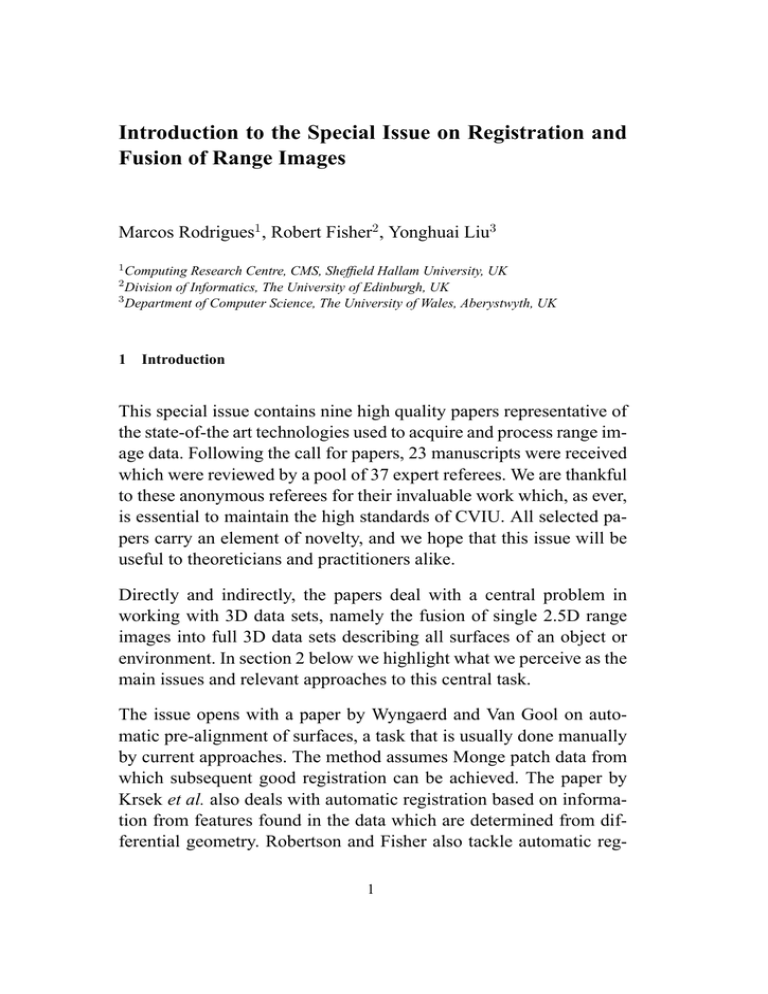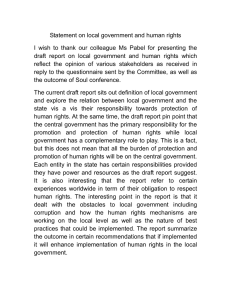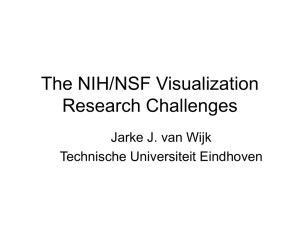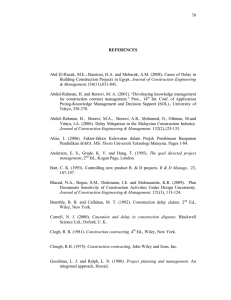Introduction to the Special Issue on Registration and Fusion of
advertisement

Introduction to the Special Issue on Registration and Fusion of Range Images Marcos Rodrigues1 , Robert Fisher2 , Yonghuai Liu3 1 Computing Research Centre, CMS, Sheffield Hallam University, UK of Informatics, The University of Edinburgh, UK 3 Department of Computer Science, The University of Wales, Aberystwyth, UK 2 Division 1 Introduction This special issue contains nine high quality papers representative of the state-of-the art technologies used to acquire and process range image data. Following the call for papers, 23 manuscripts were received which were reviewed by a pool of 37 expert referees. We are thankful to these anonymous referees for their invaluable work which, as ever, is essential to maintain the high standards of CVIU. All selected papers carry an element of novelty, and we hope that this issue will be useful to theoreticians and practitioners alike. Directly and indirectly, the papers deal with a central problem in working with 3D data sets, namely the fusion of single 2.5D range images into full 3D data sets describing all surfaces of an object or environment. In section 2 below we highlight what we perceive as the main issues and relevant approaches to this central task. The issue opens with a paper by Wyngaerd and Van Gool on automatic pre-alignment of surfaces, a task that is usually done manually by current approaches. The method assumes Monge patch data from which subsequent good registration can be achieved. The paper by Krsek et al. also deals with automatic registration based on information from features found in the data which are determined from differential geometry. Robertson and Fisher also tackle automatic reg1 istration by using an evolutionary approach to estimate transformation parameters making it a pose search method as opposed to correspondence search. Assuming that data are pre-registered, Masuda presents the method of signed distance fields for iterative shape integration and registration. Also assuming pre-registration, Okatani and Deguchi deal with fine registration using measurement error properties as an alternative to the standard Iterative Closest Point (ICP) algorithm. Using acoustic data, Castellani et al. propose an ICP variant that is robust to noise and is based on the even distribution of registration errors and on the introduction of algebraic constraints on the transformations. Sablatnig and Kampel deal with the problem of registering front and back views of rotationally symmetric objects using a model based approach in connection with the ICP algorithm. Dalley and Flynn present a comparative study of ICP based algorithms aiming at testing their robustness at outlier classification. Finally, Gupta et al. take the ICP method to another dimension namely the compression of time-dependent 3D geometric data. 2 Issues and Approaches Here we briefly summarize the issues that are driving the different research strands in the area of range data registration and fusion. From our perspective, registration is the key to fusion, so most of the issues and approaches discussed below are related to registration. 2.1 2.1.1 Range Data Registration Initial Registration and Range of Convergence Most registration algorithms use an iterative algorithm that ideally converges to the best multiple data set registration. Many algorithms only converge to a good solution if the initial relative pose estimate is sufficiently close to the optimal registration. So, one issue is how to find a good initial relative pose estimate. Further, different approaches have a wider range of tolerance about the optimal pose within which 2 convergence occurs, so researchers are investigating methods for increasing the range and robustness. The main approaches can be classified as: 1) using special features or points for initial alignment (1; 12; 14; 23; 33; 40; 73; 76) 2) special circumstances, such as properties of the registered objects or of the imaging device (6; 19; 59; 74), 3) human assisted registration (54). It is interesting to note that even with good initialisation, algorithms may not find an optimal registration or even may not be able to refine the initial coarse registration. This is due to a large number of local minima due to noise, occlusion, appearance and disappearance of points, and general lack of knowledge about the distribution of points. Moreover, the distribution and characteristics of these local minima are dependent on image data of specific objects rendering it difficult to theoretically characterise these local minima. Consequently, finding an optimal solution is an unresolved issue and future research may have to focus on investigating trully general purpose registration techniques with a large convergence range without requiring good initialisation. 2.1.2 Inexact Correspondences Two or more 3D data sets are unlikely to be acquired such that the 3D data points exactly correspond. For example, the sampling density might be different due to scanner settings, scanner distance or surface slopes. Thus, a point or feature in one data set will not have an exact correspondence in another data set, yet some sort of alignment between the elements in the two data sets will be needed. Hence, methods for finding appropriate correspondences is being researched (7; 13; 19; 49). However, it is observed that registration errors are a function of interpoint distances and thus, the resolution of the scanning. The smaller such distances, the larger the potential for accurate registration. This suggests that registration accuracy may be improved from fitted surfaces. 3 2.1.3 Outliers/Partial Overlap When registering two (or more) data sets, there are usually 3D data points or other features that do not have any correspondence between the data sets. The two main causes of this are: 1) regions of the data where there is no overlap (a natural consequence of extending the data description by incrementally fusing partially overlapping data) and 2) noise outliers (10; 18; 51; 62; 79). Hence, great effort has been made to identify outliers and partial overlap based on techniques such as high dimensional distance measurement (37; 24; 63), orientation consistency (79), interpoint distance (20), boundary points removal (57; 72), threshold (62), and motion properties (42; 43; 56). It has been shown that the identification of outliers and partial overlap are essential steps to the estimation of motion parameters. Moreover, these two steps are often interweaved and affect each other especially when no exact information is available about the distribution of points, occlusion, appearance and disappearance of points. This implies that assuming image data as a black or grey box, the development of techniques to register such data is still a challenging task and prone to local minimum convergence as pointed out above. Future research may focus on the use of structural data information, motion properties, special information on objects, or special imaging configurations for a more accurate estimation of image correspondences. 2.1.4 Pose versus Correspondence Search Most registration algorithms align data sets by finding approximately corresponding data features and then estimating the pose that aligns these. A problem that arises from this approach is the convergence to significantly misaligned local minima, which can happen when the data sets are initially far from correct alignment or slight misalignment when near to the global optimum. More recent research has started search in the pose space instead of the correspondence space and seem to be finding a broader range of initial poses that still lead to convergence near the correct alignment (9; 11; 25; 55). So here essentially we have to make clear how to measure the quality of 4 correspondences independent of the algorithms used to estimate the pose. At the beginning of the registration most correspondences are not correct, and the converse problem arises as how to measure the quality of the pose from such inaccurate correspondences. In fact, we may never know whether estimated correspondences are exactly right or not and this has an obvious effect on the quality of the estimated pose parameters. 2.1.5 Registerable Feature Type When searching for corresponding features in the two data sets, there are a variety of criteria that one can use for classifying points as being similar or interesting or key points, such as colour, local surface normals, local curvature shape, edgeness, texture, etc. (1; 8; 14; 22; 26; 36; 37; 38; 62; 66; 70; 73; 78). All such features are to varying degrees sensitive to noise and other conditions such as occusion and thus, the extraction of such features is also a challenging task. This contrasts with using the points directly (5; 19; 21) with the shortcoming that such algorithms often require good initialisation. 2.1.6 Performance Acceleration The correspondence search algorithms generally have a large potential space to search through in order to find corresponding features. There are several approaches to reducing the computational complexity of this search, including coarse-to-fine strategies (12; 29; 41; 57; 69). The use of k-D trees is particularly popular (e.g. (21; 62)). 2.1.7 Improving Registration Accuracy Accurate 3D object reconstruction requires accurate data alignment as well as having accurate data to begin with. Given the iterative nature of many of the alignment algorithms, researchers are investigating methods of avoiding local minima in the search space (9; 11; 12; 44; 55). A second statistical approach uses better information about the uncertainty of measurements themselves for the alignment and 5 fusion (10; 18; 27; 30; 45; 50; 52; 67; 68; 69; 71). 2.1.8 Multiple View Registration If more than two data sets are to be fused, then one can merge the data sets incrementally (e.g. (5; 61; 13) and many others) or simultaneously (2; 3; 4; 7; 15; 16; 21; 28; 39; 47; 48; 49; 54; 77). The incremental method is efficient and requires less computer memory but the registration error can accumulate and redundant data are not fully utilised to improve registration. The simultaneous method makes full use of redundant data, but it often involves more intensive computation for optimisation and requires a huge amount of computer memory and, at least theoretically, yields more accurate registration results. 2.2 Range Data Fusion There is still considerable research into the different approaches to fusing multiple 3D data sets, with no clearly superior approach so far. The two main classes are based on fusing surface-based representations such as triangulation (33; 64; 65; 72) or fusing multiple point sets into volumes or fusing the volumes created from the multiple point sets individually (17; 34; 35; 48; 46; 60; 75). An important issue is how to manage the fusion of data in the overlap region (53; 58; 64; 72). Many researchers do registration first and then fuse the data as a final step, but iterative registration and fusion processes are being investigated (7; 48). References [1] [2] A. Ashbrook, R. B. Fisher. Constructing models of articulating objects: range data partitioning. Proc. Int. Conf. on 3-D Digital Imaging and Modeling, pp 164-172, 1997. R. Benjemmaa, F. Schmidt. Fast global registration of 3D sam6 [3] [4] [5] [6] [7] [8] [9] [10] [11] [12] [13] [14] pled surfaces using a multi-z-buffer technique. Imag. and Vis. Comp., 17(2):113-123, Feb 1999. R. Bergevin, D. Laurendeau, D. Poussart. Registering range views of multipart objects. Comp. Vis. and Image Under., 61(1):1-16, Jan 1995. R. Bergevin, M. Soucy, H. Gagnon, D. Laurendeau. Towards a general multiview registration technique. IEEE Trans. Pat. Anal. and Mach. Intel., 18(5):540-547, May 1996. P. Besl, N. D. McKay. A method for registration of 3-D shapes. IEEE Trans. Pat. Anal. and Mach. Intel., 14(2):239-256, 1992. E. Bittar, S. Lavalée, R. Szeliski. A method for registering overlapping range images of arbitrary shaped surfaces for 3-D object reconstruction. Proc. SPIE Vol 2059, Sensor Fusion VI, pp 322336, 1993. G. Blais, M. D. Levine. Registering multiview range data to create 3D computer objects. IEEE Trans. Pat. Anal. and Mach. Intel. 17(8):820-824, August 1995. A. D. Brett, A. Hills, C. J. Taylor. A method of 3D surface correspondence and interpolation for merging shape examples. Image and Vis. Comp. 17(8):635-642, June 1999. K. Brunnström, A. J. Stoddart. Genetic algorithms for free-form surface matching. Proc. 13th Int. Conf. on Pat. Rec., IV: pp 689693, 1996. U. Castellani, A. Fusiello, V. Murino. Registration of multiple acoustic range views for underwater scene reconstruction. Comp. Vis. and Image Understanding. This issue. V. Charvillat, B. Theisse. Registration of stereo based 3D maps for object modeling: a stochastic yet intelligent solution. Proc. 13th Int. Conf. on Pat. Rec., I: pp 780-785, 1996. C. S. Chen, Y. P. Hung, J. B. Cheng. RANSAC-based DARCES: A new approach to fast automatic registration of partially overlapping range images. IEEE Trans. Pat. Anal. and Mach. Intel., 21(11):1229-1234, Nov 1999. Y. Chen, G. Medioni. Object modeling by registration of multiple range images. Image and Vis. Computing, 10(3):145-155, 1992. C. S. Chua, R. Jarvis. 3D free-form surface registration and object recognition. Int. J. Comp. Vis., 17(1):77-99, 1996. 7 [15] D. Chung, I. Yun, S. Lee. Registration of multiple-range views using the reverse-calibration technique. Pat. Recog. 31(4):457464, Apr. 1998. [16] S. J. Cunningham, A. J. Stoddart. N-view point set registration: A comparison. Proc. Brit. Mach. Vis. Conf., pp 234-244, 1999. [17] B. Curless and M. Levoy. A volumetric method for building complex models from range images. Proc. SIGGRAPH, New York, pp 303-312, 1996. [18] G. Dalley, P Flynn. Range image registration: a study in outlier classification. Comp. Vis. and Image Understanding. This issue. [19] C. Dorai, G. Wang, A. K. Jain, C. Mercer. Registration and integration of multiple object views for 3D model construction. IEEE Trans. Pat. Anal. and Mach. Intel., 20(1):83-89, Jan 1998. [20] C. Dorai, G. Wang, A. K. Jain, and C. Mercer. From Images to models: automatic model construction from multiple views. Proc. ICPR, pp. 770-774, 1996. [21] D. Eggert, A. W. Fitzgibbon, R. B. Fisher. Simultaneous registration of multiple range views for use in reverse engineering of CAD models. Comp. Vis. Image Under. 69(3):253-272, Mar 1998. [22] O. Faugeras, M. Hebert. The representation, recognition, and locating of 3-D objects. Int. J. of Rob. Res, 5(3):27-52, 1986 [23] J. Feldmar, N. Ayache. Rigid, affine and locally affine registration of free-form surfaces. Int. J. Comp. Vis, 18(2):99-119, May 1996. [24] J. Feldmar, N. Ayache, and F. Betting. 3D-2D projective registration of free-form curves and surfaces. Computer Vision and Image Understanding, vol. 65, pp. 403-424, 1997. [25] A. W. Fitzgibbon. Robust Registration of 2D and 3D Point Sets. Proc. Brit. Mach. Vis. Conf. pp 411-420, 2001. [26] G. Godin, D. Laurendeau, R. Bergevin. A method for the registration of attributed range images. Proc. 3rd Int. Conf. on 3-D Digital Imaging and Modeling, pp 179-186, 2001. [27] J. Goldberger. Registration of multiple point sets using the EM algorithm. Proc. Int. Conf. Comp. Vis., pp 730-736, 1999. [28] A. Goshtasby. Three-dimensional model construction from multiview range images: survey with new results. Pattern Recog. 31(11):1705-1714, Nov 1998. 8 [29] M. Greenspan, G. Godin. A nearest neighbour method for efficient ICP. Proc. 3rd Int. Conf. on 3-D Digital Imaging and Modeling, pp 161-168, 2001. [30] J. Guehring. Reliable 3D surface acquisition, registration and validation using statistical error models. Proc. 3rd Int. Conf. on 3-D Digital Imaging and Modeling, pp 224-231, 2001. [31] E. Guest, E. Berry, R. A. Baldock, M. Fidrich, M. A. Smith. Robust Point Correspondence Applied to Two- and ThreeDimensional Image Registration. IEEE Trans. Pat. Anal. and Mach. Intel. 23(2):165-179, Feb 2001. [32] S. Gupta, K. Sengupta, A. A. Kassim. Compression of dynamic 3D geometry data using Iterative Closest Point algorithm. Comp. Vis. and Image Understanding. This issue. [33] K. Higuchi, M. Hebert, K. Ikeuchi. Building 3-D models from unregistered range images. Graphical Models and Imag. Proc., 57(4):315-333, 1995. [34] A. Hilton, A. J. Stoddart, J. Illingworth, T. Windeatt. Reliable surface reconstruction from multiple range images. Proc. Eur. Conf. on Comp. Vis, pp 117-126, 1996. [35] H. Hoppe, T. DeRose, T. Duchamp, M. Halstead, H. Jin, M. McDonald, J. Schweitzer, W. Stuetzle. Piecewise smooth surface reconstruction. Proc. SIGGRAPH, pp 295-302, 1994. [36] A. Johnson, M. Hebert. Surface registration by matching oriented points. Proc. Int. Conf. on Recent Adv. in 3-D Digital Imaging and Modeling, pp 121-128, 1997. [37] A. Johnson, S. B. Kang. Registration and integration of textured 3-D data. Image and Vision Comp., 17(2):135-147, Feb 1999. [38] B. Kamgar-Parsi, J. L. Jones, A. Rosenfeld. Registration of multiple overlapping range images: scenes without distinctive features. IEEE Trans. Pat. Anal. and Mach. Intel. 13(9):857-871, Sept. 1991. [39] Y. Kawai, T. Ueshiba, T. Yoshimi, M. Oshima. Reconstruction of 3D objects by integration of multiple range data. Proc. 11th Int. Conf. on Pat. Rec., Vol I: 154-157, 1992. [40] P. Krsek, T. Pajdla, V. Hlavac. Differential invariants as the base of triangulated surface registration. Comp. Vis. and Image Understanding. This issue. [41] C. Langis, M. Greenspan, G. Godin. The parallel iterative clos9 [42] [43] [44] [45] [46] [47] [48] [49] [50] [51] [52] est point algorithm. Proc. 3rd Int. Conf. on 3-D Digital Imaging and Modeling, pp 195-202, 2001. Y. Liu and M. A. Rodrigues. Geometrical analysis of two sets of 3D correspondence data patterns for the registration of freeform shapes. Journal of Intelligent and Robotic Systems, vol. 33, pp. 409-436, 2002. Y. Liu, M.A. Rodrigues, and Y. Wang. Developing rigid motion constraints for the registration of free-form shapes. Proc. IEEE/RSJ IROS, pp. 2280-2285, 2000. J. Luck, C. Little, and W. Hoff. Registration of range data using a hybrid simulated annealing and iterative closest point algorithm. Proc. of IEEE Int. Conf. on Rob. and Auto., San Francisco, April 24-28, 2000. T. Masuda, N. Yokoya. A robust method for registration and segmentation of multiple range images. Comp. Vis. Image Under. 61(3):295-307, May 1995. T. Masuda. A unified approach to volumetric registration and integration of multiple range images. Proc. 14th Int. Conf. on Pat Recog., pp 977-981, 1998. T. Masuda. Generation of geometric model by registration and integration of multiple range images. Proc. 3rd Int. Conf. on 3-D Digital Imaging and Modeling, pp 254-261, 2001. T. Masuda. Registration and Integration of Multiple Range Images by Matching Signed Distance Fields for Object Shape Matching. Comp. Vis. and Image Understanding. This issue. P. Neugebauer. Geometrical cloning of 3D objects via simultaneous registration of multiple range images. Proc. Int. Conf. on Shape Modeling and Appl., pp 130-139, Aizu-Wakamatsu, Japan, March 1997. I. S. Okatani, K. Deguchi. A method for fine registration of multiple view range images considering the measurement error properties. Comp. Vis. and Image Understanding. This issue. T. Pajdla, L. Van Gool. Matching 3D curves using semidifferential invariants. Proc. 5th Int. Conf. on Comp. Vis., pp 390-395, 1995. X. Pennec, J. P. Thirion. A framework for uncertainty and validation of 3-d registration methods based on points and frames. Int. J. Comp. Vis. 25(3):203-229, Dec 1997. 10 [53] R. Pito. Mesh integration based on co-measurements. IEEE Int. Conf. on Image Proc., vol. 2, pp. 397-400, Laussane, Switzerland, 1996. [54] K. Pulli. Multiview registration of large data sets. Proc. 2nd Int. Conf. on 3-D Digital Imaging and Modeling, pp 160-168, 1999. [55] C. Robertson, R. B. Fisher. Parallel Evolutionary Registration of Range Data. Comp. Vis. and Image Understanding. This issue. [56] M.A. Rodrigues and Y. Liu. On the representation of rigid body transformations for accurate registration of free form shapes. Robotics and Autonomous Systems, vol. 39, pp. 37-52, 2002. [57] S. Rusinkiewicz, M. Levoy. Efficient variants of the ICP algorithm. Proc. 3rd Int. Conf. on 3-D Digital Imaging and Modeling, pp 145-152, 2001. [58] M. Rutishauser, M. Stricker, M. Trobina. Merging range images of arbitrarily shaped objects. Proc. IEEE Int. Conf. on Comp. Vis. and Pat. Recog., pp 573-580, 1994. [59] R. Sablatnig, M. Kampel. Model-based registration of frontand back views of rotationally symmetric objects. Comp. Vis. and Image Understanding. This issue. [60] Y. Sakaguchi, H. Kato, K. Sato, S. Inokuchi. Acquisition of entire surface data based on fusion of range data. IEEE Trans. E74(10):3417-3422, Oct 1991. [61] A. D. Sappa, M. A. Garcı̀a. Incremental Multiview Integration of Range Images. Proc. Int. Conf. on Pat. Rec. Vol I: 546-549, 2000. [62] C. Schütz, T. Jost, H. Hügli. Multi-feature matching algorithm for free-form surface registration. Proc. Int. Conf. on Pat. Recog., pp 982-984, 1998. [63] G. C. Sharp, S. W. Lee, and W. K. Wehe. ICP registration using invariant features. IEEE Trans. PAMI, vol. 24, pp. 90-112, 2002. [64] M. Soucy, D. Laurendeau. A general surface approach to the integration of a set of range views. IEEE Trans. Pat. Anal. and Mach. Intel. 17(4):344-358, April 1995. [65] M. Soucy. D. Laurendeau. A dynamic algorithm to model surfaces from multiple range views. Mach. Vis. and Appl., 8(1):5362, 1995. [66] I. Stamos, P. Allen. Automatic Registration of 2-D with 3-D Imagery in Urban Environments, Proc. Int. Conf. Comp. Vis, II: 11 [67] [68] [69] [70] [71] [72] [73] [74] [75] [76] [77] [78] [79] 731-736, 2001. A. J. Stoddart, K. Brunnström. Free-form surface matching using mean field theory. Proc. Brit. Mach. Vis. Conf. pp 33-42, 1996. A. J. Stoddart, A. Hilton. Registration of multiple point sets Proc. 13th Int. Conf. on Pat. Recog., Vol II, pp 40-44, 1996. J. P. Tarel, N. Boujema. A coarse to fine 3D registration method based on fuzzy clustering. Comp. Vis. and Image Under., 73(1):14-28, Jan 1999. J.-P. Thirion. New feature points based on geometric invariants for 3D image registration. Int. J. Comp. Vis., 18(2):121-137, May 1996. E. Trucco, A. Fusiello, V. Roberto. Robust motion and correspondence of noisy 3-D point sets with missing data. Pat. Rec. Let. 20(8):889-898, Aug 1999. G. Turk, M. Levoy. Zippered polygon meshes from range images. Proc. SIGGRAPH94, pp 311-318, July 1994. J. Vanden Wyngaerd, L. Van Gool. Automatic crude patch registration. Comp. Vis. and Image Understanding. This issue. B. C. Vemuri, J. K. Aggarwal. 3-D model construction from multiple views using range and intensity data. Proc. IEEE Conf. on Comp. Vis. and Pat. Rec., pp 435-437, 1986. M. D. Wheeler, Y. Sato, K. Ikeuchi. Consensus surfaces for modeling 3D objects from multiple range images. Proc. 6th Int. Conf. on Comp. Vis., pp 917-924, 1997. J. Williams, M. Bennamoun. A multiple view 3D registration algorithm with statistical error modeling. IEICI Trans. Inf. and Sys., E83-D(8):1662-1670, Aug 2000. J. Williams, M. Bennamoun. Simultaneous registration of multiple corresponding point sets. Comp. Vis. and Image Under., 81(1):117-142, 2001. S. Yamany, A. Farag. Free-form surface registration using surface signatures. Int. Conf. Comp. Vis., pp 1098-1104, 1999. Z. Zhang. Iterative point matching for registration of free-form curves and surfaces. Int. J. of Computer Vision, 13(2):119-152, Oct 1994. 12


